This report was first published in Newsletter 128, April 2016.
Rikki Harrington is Vice President, Hertfordshire Scouts and Vice President, Harpenden and Wheathampstead District Scouts.
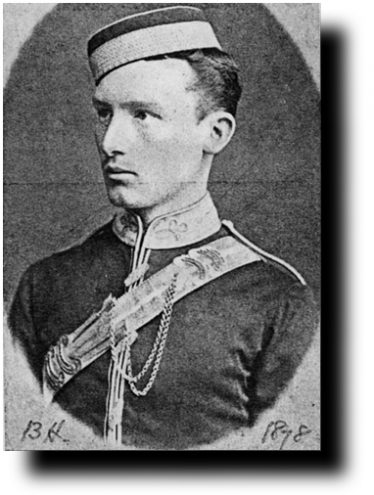
Robert Baden Powell in 1878. Credit: History of Scouting
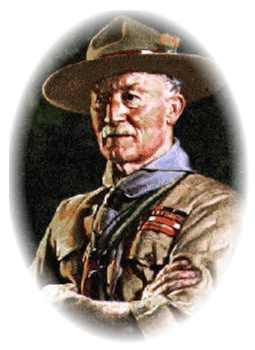
Robert Baden Powell. Credit: History of Scouting
Robert Baden-Powell (B-P) was born on 22nd February 1857. His mother, Henrietta, often said to him: “We cannot be good ourselves unless we are always helping others”. The ethos of Scouting was planted at an early age. B-P went to Charterhouse School. He got a Commission with the 13th Hussars. His military interests were in reconnaissance. During the siege of Mafeking (1899/1900), B-P received invaluable help from the youth of Mafeking, which undoubtedly influenced his thinking on Scouting. On return, he was invited to inspect a Boys’ Brigade parade by its founder Sir William Smith. B-P suggested that more boys might join if there was a more adventurous programme. Smith asked for a practical scheme and this led to B-P adapting his book Aids to Scouting, originally aimed at NCOs.
Trial run at Brownsea Island
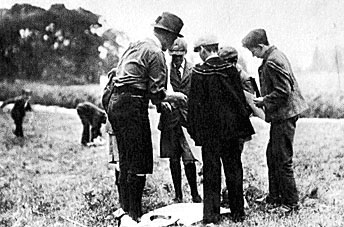
Brownsea Island camp. Credit: History of Scouting
Partly as a result of discussions with Smith, the idea of the experimental camp on Brownsea Island (1st – 8th August 1907) developed. Its aim was to try out B-P’s ideas on good citizenship. Ten boys from the Poole and Bournemouth Boys’ Brigade and ten public school sons of B-P’s friends were invited. B-P had not intended to start a new movement.
In 1908 Scouting for Boys was published. It has never been out of print. As a result boys everywhere hunted down adults to become Scout Leaders and Scouting was born.
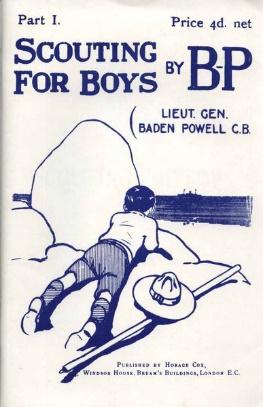
Credit: History of Scouting
Some milestones of national Scouting
- 1907 Foundation
- 1909 Sea Scouts were started.
- 1910 Girl Guides were started with the help of Olave Soames.
- 1910 The number of Scouts passed 100,000.
- 1912 B-P (55) married Olave Soames (23). They had one son and two daughters.
- 1916 Wolf Cubs started.
- 1920 1st World Jamboree, Olympia, attended by 8,000 Scouts from 34 nations.
- 1932 The first Gang Show was held at the Scala Theatre in London.
- 1941 Air Scouts started.
- 1966 Major modernisation of programme, uniform, image, structures.
- 1976 Girls allowed to join Venture Scouts.
- 1986 Beaver Scouts (aged 6-7) started.
- 2007 Centenary: more major updates; girls had to have equal access as did boys.
Scouting in Hertfordshire
B-P first met Percy Everett through the publisher Sir Arthur Pearson, for whom he worked. Everett was invited to the Brownsea Island camp. As Scouting began to take off, Everett asked B-P how he could help. “Go back to Hertfordshire and establish it as a Scout County”, was the response.
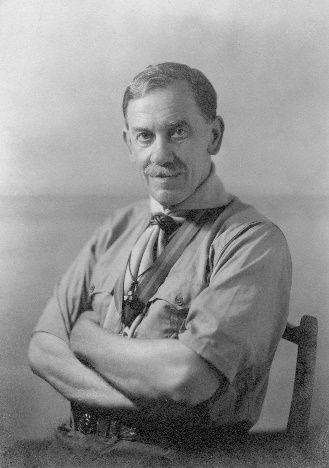
Sir Percy Everett
Other Counties were modelled on the structure developed by Everett. In 1941, following the death of B-P, Everett was appointed by Lord Somers, the new Chief Scout, as his Deputy. Everett was knighted in 1930 for services to Scouting.
The Scout was first published (by Pearsons) in 1908 and ran weekly until 1966. From 1919 until 1954 it was edited by Hertfordshire’s F. Haydn Dimmock. He was responsible for several national initiatives, including Bob-A-Job week, which began in 1949.
Vera Barclay was a Scout Leader from the Hertford Heath Troop. In 1914 she experimented with programmes for the under 11’s and went with Percy Everett to meet B-P to discuss her ideas. She played a major role in developing the Wolf Cubs.
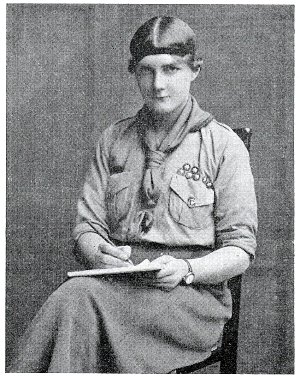
Vera Barclay
Today there are around 17,000 Scouts in Hertfordshire.
Scouting in Harpenden: Formation of the District
The District was formed in July 1909. The President was Sir Charles Lawes-Wittewronge. The first records at Scout HQ were not kept until 1919. At that time the District Commissioner was Lt Col F. G. Hill.
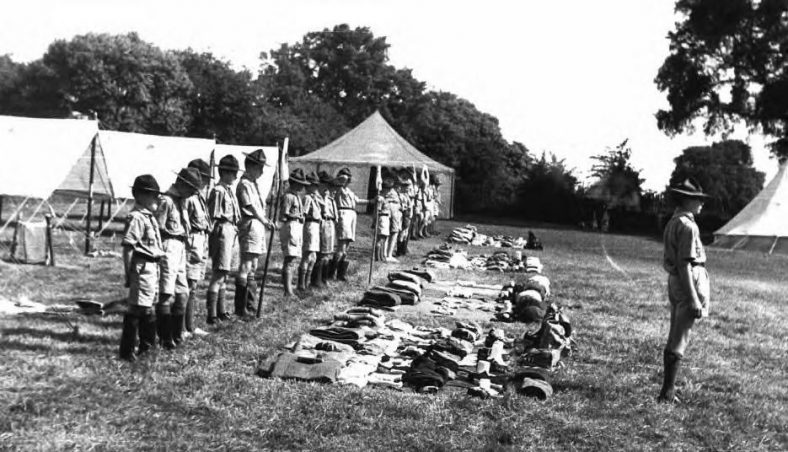
Camp in Rothamsted Park
Annual camps were held in Rothamsted Park from the late 1940s and were combined with a fundraising fete. In 1951 District Commissioner Tommy Shadbolt organised the Festival Revels. The Carnival Queen was chosen at the Scout fete. The camps continued until the late 1950s.
Harpenden and District Scout Groups:
- First Harpenden: Opened 1908. Closed WW1. Restarted 1920. Linked with Methodist Church from 1930. Granary Lane HQ opened on 12 May 1956 in the former wartime hut on ‘Cowper Meadow’.
- Second Harpenden: *revised with information from John Seabrook. Opened 1908. At one time linked with St Hilda’s School (Geoff Woodward). Restarted 1920, sponsored by St John’s Church. Absorbed into the 3rd 1935/36. Restarted at Batford by Bob Beckwith about 1950. Closed around 1975. Recently reborn at Tallents Crescent.
- Third Harpenden: Opened 1908. Unbroken history. Current HQ opened on 2 July 1932 in premises of former Rifle Club
- Fourth Harpenden: Opened 1920 attached to St George’s School (at the Coldharbour Mission in 1928). In 1930 First Batford became Fourth Harpenden.
- Fifth Harpenden: Opened 1920 “Lady Ludlow’s Own”. Restarted in Luton Road Mission under St Nicholas Parish Church in 1930s. Dedicated to “Extension Scouting”. Closed in May 1938. Restarted recently at Wood End School.
- Sixth Harpenden: Opened 1950 at Aldwickbury School. Closed around 1970.
- Seventh Harpenden: Opened after WW2 at National Children’s Home, Harpenden Oval. Closed around 1948.
- Eighth Harpenden: Accounts vary. Very little known.
- Ninth Harpenden: Opened 1960s at 110 Luton Road church hall (since demolished) until March 1971. New HQ in Kinsbourne Green ready in September 1971 and officially opened on 28 April 1973.
- Tenth Harpenden: Opened around 1962 at Southdown. Moved to Waldegrave Park around 1980.
- Eleventh Harpenden: Opened 1977, sponsored by United Reformed Church. Did not last long.
- Twelfth Harpenden: Opened 1992, sponsored by St Nicholas Church.
- First Wheathampstead: Opened 1908. Unsure when closed. Reopened 1965.
- First Kimpton: Opened around 1914.
In addition there are Explorer Scout Units (previously Venture Scouts and Rover Scouts).
Harpenden Gang Show
The Harpenden & Wheathampstead District Scout Gang Show first took place in October 1949, as a one-off. Such was the clamour afterwards that it was decided to make it an annual event. As the Public Hall was booked out the following autumn, the first available date for the 2nd Show was in January 1951, and it has been January every year since. It is the world’s longest running Gang Show without a break.
Acknowledgements
- The account of national Scouting draws on the book An Official History of Scouting (Hamlyn, 2006).
- The account of Hertfordshire Scouting draws on the knowledge and archive material collected by Frank Brittain, Hertfordshire Scouts County Archivist.
- The account of Harpenden Scouting draws on the knowledge and archive material of John Seabrook. Ray Fassie investigated the history of Scout Groups, and Geoff Woodward has contributed further information. Ewan Murray provided the account of the Gang Show.

Comments about this page
From 1962 to October 1965 I was an ASL for the 10th Harpenden based at the Methodist Church in Southdown. We did our own Scouting Gang show in the church hall.
In early 1980’s I was involved with the 4th Harpenden Scout and Guide Band [Drum and Bugles] and my 2 daughters marched with the band. Later became the Harpenden Corps of Drums and leaving the scouting movement.
John Seabrook has provided amendments to the brief history of 2nd Harpenden Scouts, marked with * in the summary above.
He commented that “My old pal Brian Allen (now sadly deceased) was Cub leader at the Second in the 1950s. [….] There is, of course, some conjecture in those details. Much of the official record of Harpenden Scouting was lost in a fire. St Hilda’s School was certainly involved in Scouting in the very early days, as was Hardenwick School. The actual date of St John’s Church involvement is unknown to me, but their eventual demise and inclusion into the Third is well documented.”
Ed. The 1930s records of the 2nd Harpenden Brownies pack at St Hilda’s school have survived and have been donated to the local history archives.
Add a comment about this page